
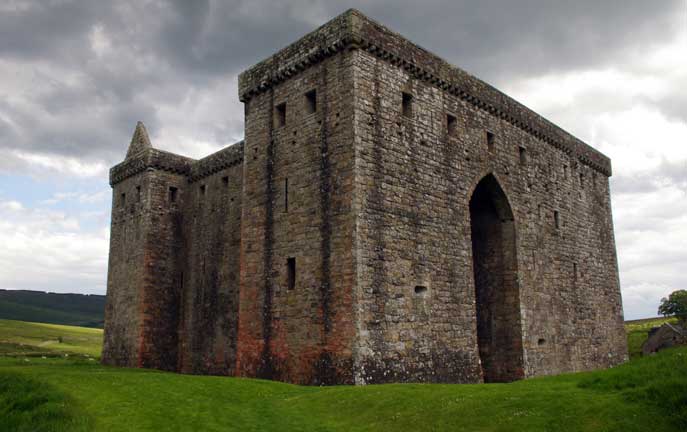
Few castles I've visited are more visually stunning than Hermitage Castle near the Scottish Border town of Necastleton Postcode: TD9 0LU
Hermitage Castle on approach is a very forbidding and oppressive place.The architecture seems utterly brutal, sheer unclimbable walls relieved only by huge arch. Radio Scotland once broadcast a feature in which Hermitage Castle was described as the embodiment of the phrase "sod off" in stone. It's a difficult description to better.
The castle is in the care of Historic Scotland, the lady who was in charge on my visit was a very cheerful lassie from Glasgow and was most informative and helpful, always good to see a welcoming face, especially in a setting as grim as this!!
If like me you like taking hundreds of photographs, you'll be in your element, great opportunities to get some very dramatic shots, especially as the sky was a brooding dark grey when I visited.
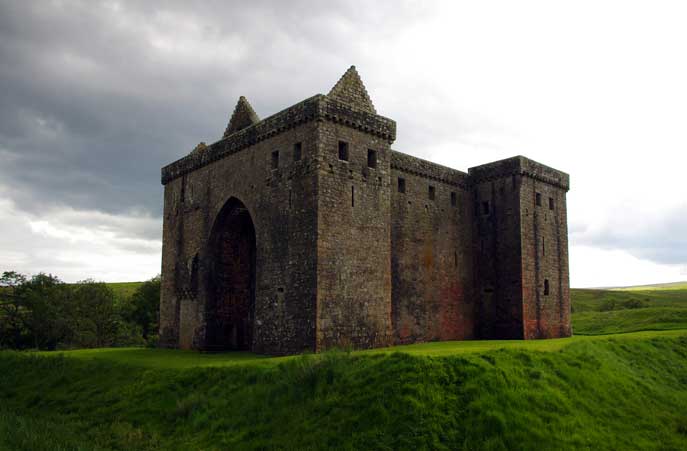
The setting also does the castle few favours. Its riverside location high in the valley of the Hermitage Water ought to be enchanting. But the bleak and open moorland that surrounds Hermitage Castle on its other three sides seems oppressive.
A wooden castle was originally built on this site by Nicholas de Soulis in 1242. With it's location being so close to the border with England, Hermitage Castle played a key role in the Wars of Independence, and it changed hands a number of times over the following decades.
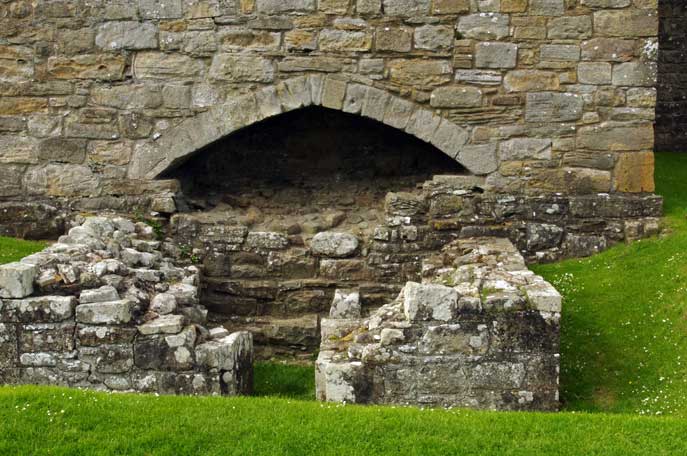
By 1320, William de Soulis, was in control of Hermitage, he was a man so widely disliked that there are two totally different stories told about how he met his demise. In one of them he plotted against Robert the Bruce and was imprisoned in Dumbarton Castle, with Hermitage being forfeited to the Crown. In the other, based on a ballad written in the 1700s, William de Soulis was boiled alive in molten lead by locals after inflicting a reign of terror on the neighbourhood. I like the second one!!
In 1338 the castle was captured by Sir William Douglas. He was an ambitious man who responded to the appointment by King David II of Alexander Ramsay as Sheriff of Teviotdale by imprisoning Ramsay in Heritage Castle and starving him to death. David II took the line of least resistance and appointed Sir William to the newly vacant post.
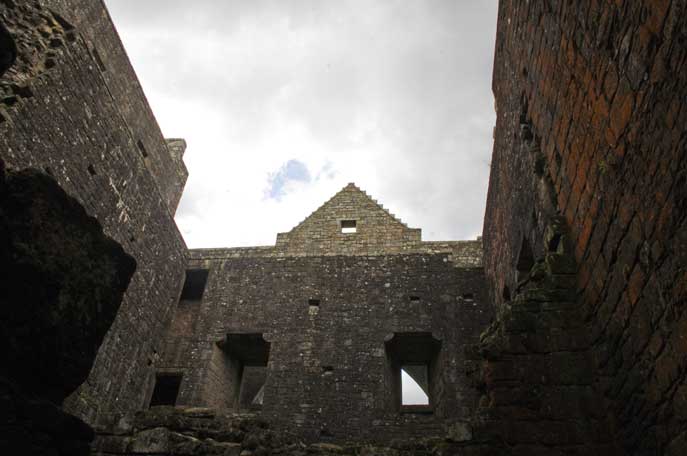
By 1371 the wooden Hermitage Castle was inherited by the first Earl of Douglas. He rebuilt it as a much stronger stone tower house. It was the third Earl of Douglas who from 1390 added four great stone towers to the corners of the castle, producing what you see today.
In 1492 James IV's doubts about the loyalty of the fifth Earl of Douglas led him to instruct that Hermitage Castle be exchanged for the less strategically sensitive Bothwell Castle, until then held by the first Earl of Bothwell.
The only hint of romance in Hermitage Castle's story came in October 1566, when it was held by James Hepburn, 4th Earl of Bothwell. He was injured in a fight with border reivers. When news of this came to the ears of Mary Queen of Scots, visiting Jedburgh, 25 miles away, she dropped everything and rode with a small retinue to be by his side.
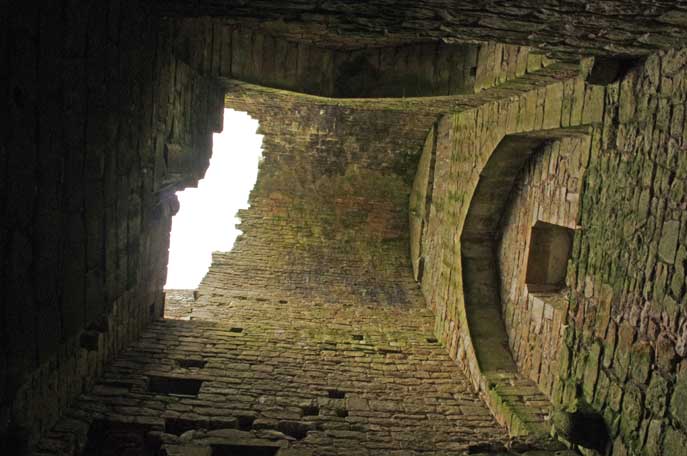
Still married at the time to Lord Darnley she could not be seen to stay at Hermitage with Bothwell so after two hours she returned the 25 miles to Jedburgh. En route she stumbled into a marsh and contracted a cold from which she nearly died.
Hermitage Castle fell into disuse in the early 1600s. Its fame as a gloomy and romantic ruin spread through the 1800s: Sir Walter Scott had himself painted with Hermitage in the background. This interest led the then owner, the fifth Duke of Buccleuch, to undertake extensive repairs which helped so much of the exterior wall to survive until the castle was placed in state care in 1930.
And if you do find yourself alone in Hermitage Castle with the wind whistling through the few openings in the walls, it's easy to understand why many visitors have reported unusual apparitions and happenings. You only have to look at this fascinating and intimidating castle to know that its very stones bear witness to events long forgotten: and perhaps best kept that way.
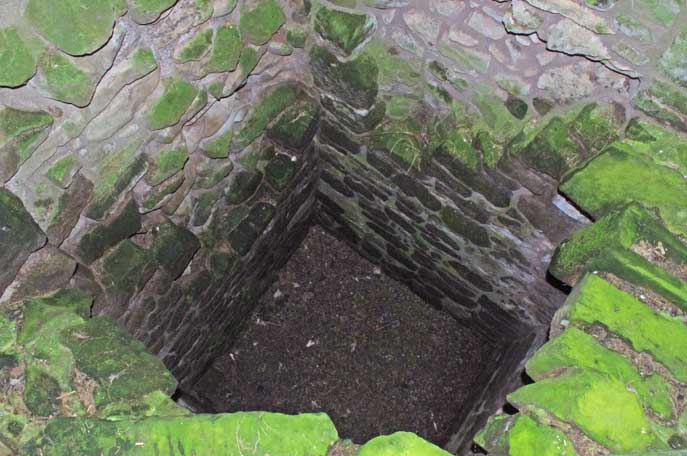
I have to admit that the castle is a very intimidating place, but there's also something quite enthralling about it as well, I'll be back but I doubt very much if I'd visit it anytime other than daylight, you on the other hand might be a lot braver than me!!
I finished my day with a visit to Scott's View and the statue of William Wallace, both near Drybrough, also if you want a tip for lunch or dinner you could do a lot worse than the Auld Cross Keys in Denholm, lovely grub in very pleasant surroundings!!

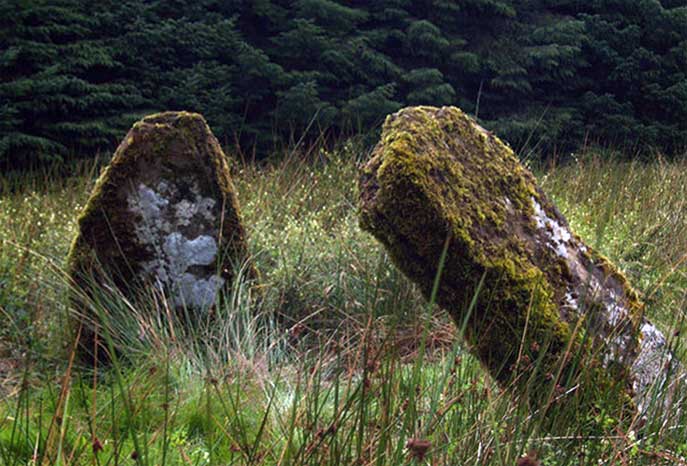
William de Soulis lived from about 1280 to about 1320. From 1318 to 1320 he was Lord of Hermitage and he was a man so deeply unpopular that there are two quite separate tales told of his demise.
Whichever way you look at it, William de Soulis seems to have been an unpleasant man, even by the standards of his many unpleasant contemporaries. You can take your pick between the stories of how he met his end. One is rather ordinary and, probably, historically accurate. The other combines deeply evil deeds, supernatural horror, and an especially gruesome but fitting end for the villain. The second version is based largely on a ballad popular in the Borders in the 1700s, which may have been based on earlier folk stories.
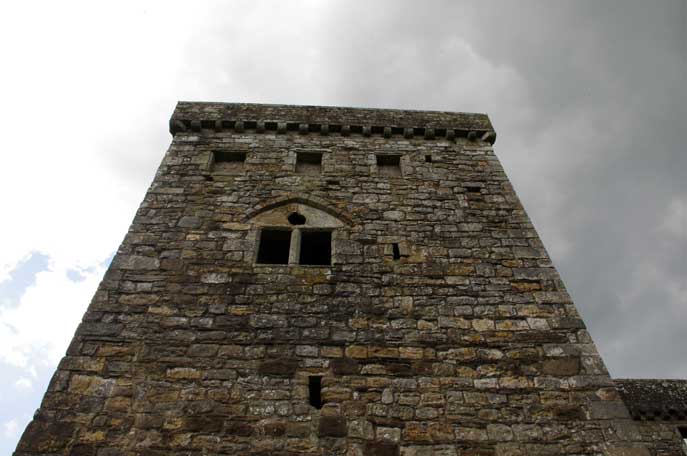
As background, the de Soulis family had been connected with forbidding Hermitage Castle in Liddesdale, close to the English border, since 1249, when Nicholas de Soulis built a wooden castle here. In 1318, his descendant, William de Soulis, became Lord of Hermitage. It is unlikely that the original wooden castle had yet been replaced in stone, but today's Hermitage Castle is an oppressive and chilling place that gives credence to even the most fanciful of the stories concerning William do Soulis.
But first, the boring, historical bit. Border lords at the time were always having to look closely at whether their interests were best served by siding with the English or the Scots, and it seems that in 1320 William de Soulis took part in an English-inspired plot to kill the Scottish king, Robert the Bruce. It failed, and the participants were rounded up, with de Soulis being imprisoned in Dumbarton Castle, where he subsequently died.
The second version takes a little longer to tell. William de Soulis was a huge and physically powerful man, and when he became Lord of Hermitage in 1318 he rapidly demonstrated a deep vein of cruelty that quickly had him loathed by all who came into contact with him. Stories began to circulate that he practiced the Black Arts, kidnapping local children and using their blood in dark rituals at Hermitage Castle.
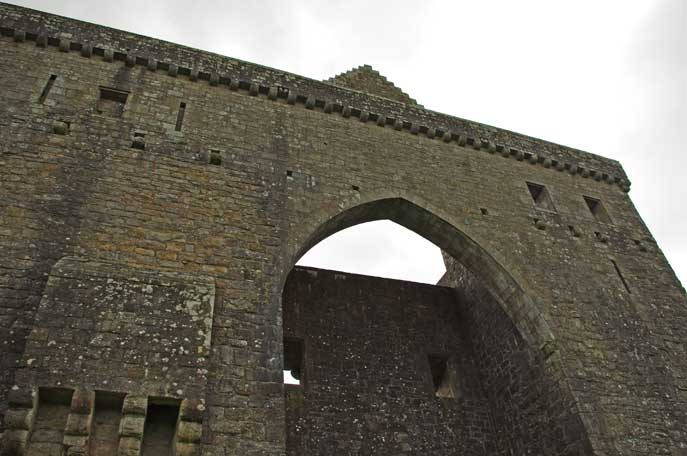
During these rituals, de Soulis would summon up his familiar, Robin Redcap. A redcap, also known as a powrie or dunter, is a type of evil goblin, typically found in British folklore in ruined castles along the border between England and Scotland. Once summoned they roam the area, killing travellers and residents in order to keep fresh the bloodstains on the redcap's hat: because if these stains dry, the redcap dies.
Redcaps are very quick, despite their metal-bound boots and the heavy pike they carry, and the only way to escape one is to quote a passage from the Bible at it, whereupon it loses a tooth. Robin Redcap was especially feared, and after being summoned by de Soulis committed many evil deeds in the lands around Hermitage.
But William de Soulis himself was equally capable of terrorising his neighbours. One day in 1320 he kidnapped a young Armstrong woman and tried to return with her to Hermitage Castle. When her father tried to stop him, de Soulis killed him on the spot. However, by now a crowd had gathered, and de Soulis was on the verge of being lynched when Alexander Armstrong, the Laird of Mangerton, intervened, calming the crowd and advising de Soulis to return to Hermitage without his captive.
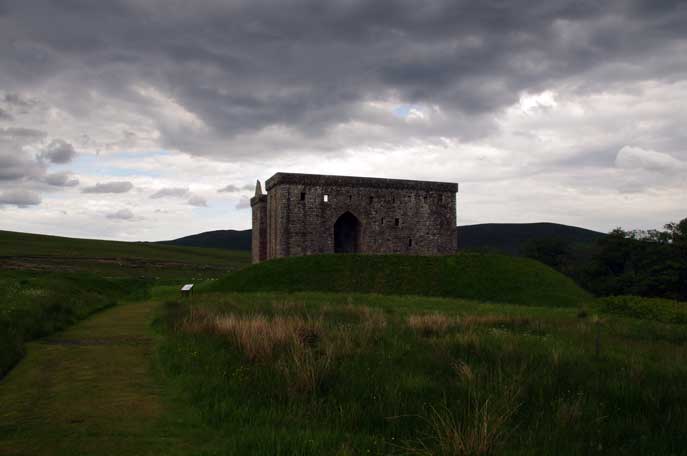
De Soulis was far from grateful, instead developing a hatred for someone who, as his social inferior, had demonstrated the power to influence the crowd and save de Soulis's life. De Soulis therefore invited Alexander Armstrong to a banquet at Hermitage, and when he arrived, stabbed him in the back.
Complaints about de Soulis's activities were frequently reaching the ears of King Robert the Bruce himself, and when he was told of this latest outrage, Bruce, in exasperation, cried "Soulis! Soulis! Go boil him in brew!" Needing no further invitation, the locals overpowered de Soulis, using a specially forged chain to bind him, as ordinary ropes could not contain his supernatural powers, and took him to the summit of Nine Stane Rig. It was believed that de Soulis could not be killed by ordinary means, so instead he was boiled in molten lead in a cauldron suspended above a large fire.
When news reached the king that his words were being taken literally, he sent soldiers to Hermitage: but it was too late, and they were only able to report back what had happened.
Take your pick which story you prefer, but both end in de Soulis's death; both end with the confiscation by the Crown of Hermitage Castle; and both end without evoking much sympathy for William de Soulis!

" On a circle of stones they placed the pot,
On a circle of stones but barely nine ;
They heated it red and fiery hot,
Till the burnished brass did glimmer and shine.
"They rolled him up in a sheet of lead—.
A sheet of lead for a funeral pall ;
They plunged him in the cauldron red,
And melted him, lead, and bones, and all.
" At the Skelf-hill, the cauldron still
The men of Liddesdale can show ;
And on the spot, where they boiled the pot,
The spreat and the deer-hair ne'er shall grow."

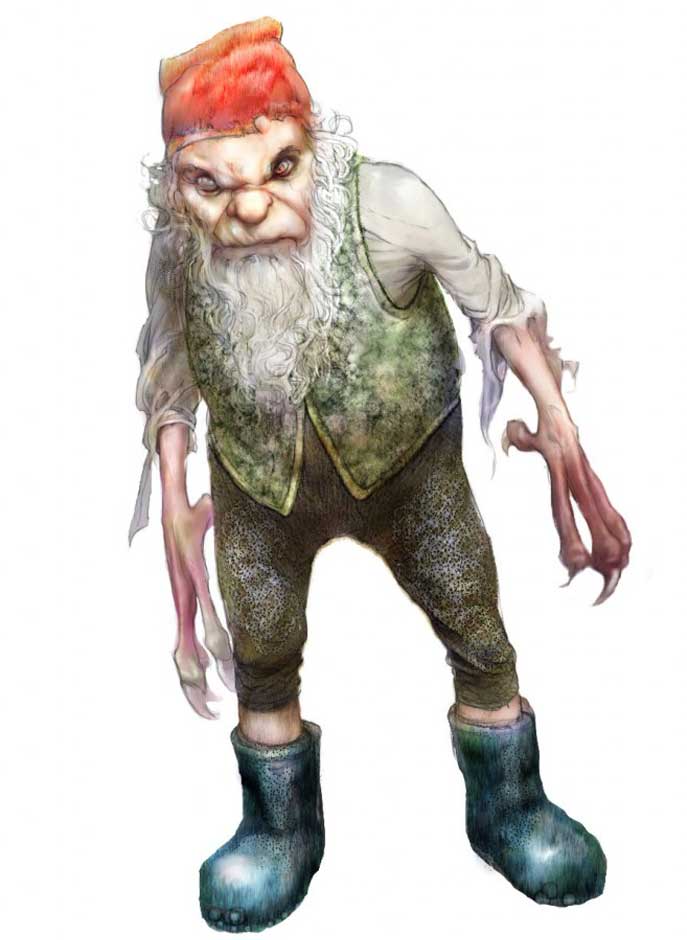
A malevolent goblin, redcaps are easily distinguishable for their namesake red hat and fiery red eyes. Their caps are red because they dip them in the blood of their human victims.
Redcaps wears iron boots, but are swift on their feet. They reside in castles and watchtowers along the English-Scottish border, however, they move their residence often to avoid detection.
Redcaps have sharp eagle's talons with which they kill humans. Short and wiry, redcaps have long white beards and look like old men. Like any goblin, all that is needed to repel them is the use of holy words.
The most infamous redcap of all was Robin Redcap. As the familiar of Lord William de Soulis, Robin wreaked much harm and ruin in the lands of his master's dwelling, Hermitage Castle.
Men were murdered, women cruelly abused, and dark arts were practiced. So much infamy and blasphemy was said to have been committed at Hermitage Castle that the great stone keep was thought to be sinking under a great weight of sin, as though the very ground wanted to hide it from the sight of God.
Yet Soulis, for all the evil he wrought, met a very horrible end. He was taken to the Nine Stane Rigg, a circle of stones hearth by the castle, and there he was wrapped in lead and boiled to death in a great cauldron.
The Redcap moves from place to place on a whim throughout the extreme lowlands of Scotland along the English border. He haunts the ruins of old castles and cairns which he guards with his life.
Redcaps must kill regularly, for if the blood staining their hats dries out, they die.
Outrunning the buck-toothed little daemons is quite impossible. The only way to escape one is to quote a passage from the Bible. They then lose a tooth on hearing it, which they leave behind.
They are emanciated old men with a leathery bodies and little or no hair.
They often carry a sharp wooden scythe or an iron pike to strike down all who invade the area they have decided to guard for the time being.
The Redcap they wear, and for which they are named, is said to be made of dried human skin. They are very fast in spite of the heavy iron pike they wield and the iron-shod boots they wear.
Redcaps are said to murder travelers who stray into their homes, sometimes by pushing boulders off cliffs and on to them and then staining their hats with their victims' blood.

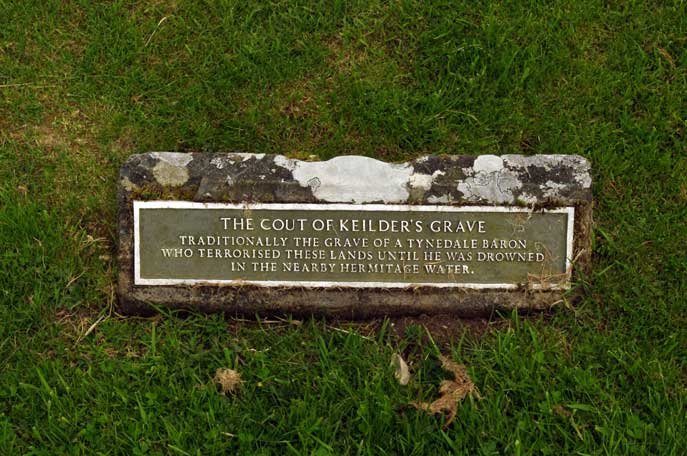
Many a warrior, no doubt, lies buried in the graveyard of Hermitage chapel, but I do not think any tombstones of very great age have ever been found. Outside, however, between the wall of the burial ground and the river, there is an interesting mound, the reputed grave of the famous Cout o' Keilder.
Keilder is a district of Northumberland adjoining Peel Fell, and in the day of the wizard Soulis, that iniquitous lord's most noted adversary was the chief of Keilder, locally called, from his great size and strength and activity, " the Cout." In his last desperate fight with Soulis and his followers on the banks of Hermitage Water, the Cout was hewing a bloody path through the press of men, towards his chief enemy, when weight of numbers forced him, like a wounded stag, to take to the water.
Here, at bay in the rushing stream, guarding him-self from the foes who swarmed on either bank, the Cout stumbled and fell, and, hampered by his armour, he could not regain his feet ; for each time that the drowning man got his head above water, Soulis and his band thrust him back with their long spears. Finally, as he became more exhausted, they held him down. And so the Cout perished.
Here on the grassy bank, hard by what is still called " The Cout o' Keilder's pool," is his grave. But one is disappointed to learn that when an examination of it was made some years ago, no gigantic bones were unearthed, nor indeed any bones at all.
Still makes for a very good story doesn't it, and we Scots never let the truth interfere with a good stoy!!
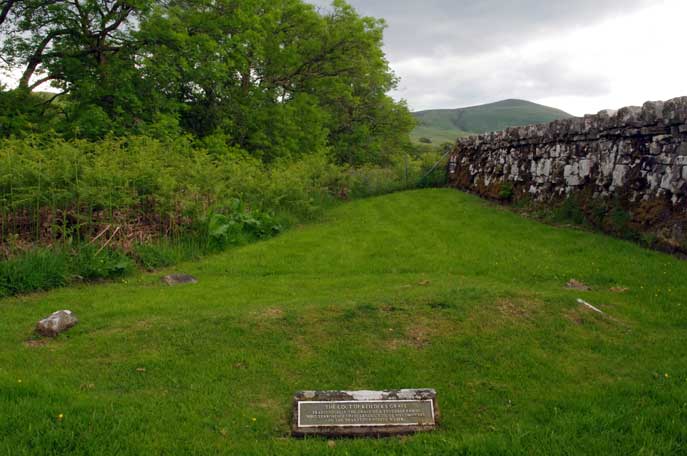
 |
For higher resolution copies and lot's more of these photo's CLICK HERE |